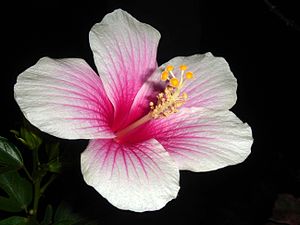Note: This is a project under development. The articles on this wiki are just being initiated and broadly incomplete. You can Help creating new pages.
Difference between revisions of "Hibiscus rosa sinensis - Rudrapushpa"
(→Uses) |
(→External Links) |
||
| Line 78: | Line 78: | ||
==External Links== | ==External Links== | ||
* [http://www.herbalcureindia.com/herbs/hibiscusrosa-sinensis.htm Rudrapushpa-herbal care india] | * [http://www.herbalcureindia.com/herbs/hibiscusrosa-sinensis.htm Rudrapushpa-herbal care india] | ||
| − | * [https://www.researchgate.net/publication/40765421_Hibiscus_rosa_sinensis_Linn_-_''Rudrapuspa''_A_Review | + | * [https://www.researchgate.net/publication/40765421_Hibiscus_rosa_sinensis_Linn_-_''Rudrapuspa''_A_Review] |
* [https://www.cabdirect.org/cabdirect/abstract/20103127113 Rudrapushpa on cabdirect.org] | * [https://www.cabdirect.org/cabdirect/abstract/20103127113 Rudrapushpa on cabdirect.org] | ||
* [https://www.ncbi.nlm.nih.gov/pmc/articles/PMC3249924/ Chemical constituents of Asparagus] | * [https://www.ncbi.nlm.nih.gov/pmc/articles/PMC3249924/ Chemical constituents of Asparagus] | ||
[[Category:Herbs]] | [[Category:Herbs]] | ||
Revision as of 15:58, 11 May 2018
Rudrapushpa is a sanskrit name of Hibiscus rosa. This floweer is originateed in China. It is also used as a Decorative flower. In Chian and Philiphines a fresh Hibiscus rosa is used for coocking.
Contents
- 1 Uses
- 2 Parts Used
- 3 Chemical Composition
- 4 Common names
- 5 Properties
- 6 Habit
- 7 Identification
- 8 List of Ayurvedic medicine in which the herb is used
- 9 Where to get the saplings
- 10 Mode of Propagation
- 11 How to plant/cultivate
- 12 Commonly seen growing in areas
- 13 Photo Gallery
- 14 References
- 15 External Links
Uses
leucorrhea, haemorrhoids, fever, burning sensation, Skin eruptions, Blotches, Pimples, Diarrhea, diabetes
Parts Used
Chemical Composition
Carbohydrates, Lipids, Proteins, Nucleotides and nucleic acids[1]
Common names
| Language | Common name |
|---|---|
| Kannada | kaama gaggare, kaama kasturi |
| Hindi | babui, babuitulsi |
| Malayalam | pach-cha-pushpam, pachcha |
| Tamil | cankanirakkarantai, capcavitai |
| Telugu | bhoo tulasi, bhu-tulasi |
| Marathi | NA |
| Gujarathi | NA |
| Punjabi | NA |
| Kashmiri | NA |
| Sanskrit | ajagandhika, ajaka |
| English | Agrimony |
Properties
Reference: Dravya - Substance, Rasa - Taste, Guna - Qualities, Veerya - Potency, Vipaka - Post-digesion effect, Karma - Pharmacological activity, Prabhava - Therepeutics.
Dravya
Rasa
Guna
Veerya
Vipaka
Karma
Prabhava
Habit
Identification
Leaf
| Kind | Shape | Feature |
|---|---|---|
| Simple | Dorsiventral | Both the glandular and stellate types of trichomes are present. Stomata are of ranunculaceous or rubiaceous typa, present on the lower surface |
Flower
| Type | Size | Color and composition | Stamen | More information |
|---|---|---|---|---|
| Unisexual | 2-4cm long | Yellow | 5-20 | Flower powder shows spheroidal, pantoporate, pore-circular pollen grains; stellate trichomes single,elongated, conical or twisted and convoluted |
Fruit
| Type | Size | Mass | Appearance | Seeds | More information |
|---|---|---|---|---|---|
| simple | 4-8 cm | clearly grooved lengthwise, Lowest hooked hairs aligned towards crown | With hooked hairs | many | {{{6}}} |
Other features
List of Ayurvedic medicine in which the herb is used
- Vishatinduka Taila as root juice extract
Where to get the saplings
Mode of Propagation
How to plant/cultivate
Numerous varieties, cultivars, and hybrids are available, with flower colors ranging from white through yellow and orange to scarlet and shades of pink, with both single and double sets of petals[3]
Commonly seen growing in areas
tropical, subtropical, temperate region.
Photo Gallery
References
External Links
- Pages that are stubs
- Ayurvedic Herbs known to be helpful to treat leucorrhea
- Ayurvedic Herbs known to be helpful to treat haemorrhoids
- Ayurvedic Herbs known to be helpful to treat fever
- Ayurvedic Herbs known to be helpful to treat burning sensation
- Ayurvedic Herbs known to be helpful to treat Skin eruptions
- Ayurvedic Herbs known to be helpful to treat Blotches
- Ayurvedic Herbs known to be helpful to treat Pimples
- Ayurvedic Herbs known to be helpful to treat Diarrhea
- Ayurvedic Herbs known to be helpful to treat diabetes
- Herbs with Leaves used in medicine
- Herbs with Roots used in medicine
- Herbs with Flowers used in medicine
- Herbs with Seeds used in medicine
- Herbs with common name in Kannada
- Herbs with common name in Hindi
- Herbs with common name in Malayalam
- Herbs with common name in Tamil
- Herbs with common name in Telugu
- Herbs with common name in Sanskrit
- Herbs with common name in English
- Habit - Herb
- Index of Plants which can be propagated by Seeds
- Index of Plants which can be propagated by Cuttings
- Herbs that are commonly seen in the region of tropical
- Herbs that are commonly seen in the region of subtropical
- Herbs that are commonly seen in the region of temperate region
- Herbs
